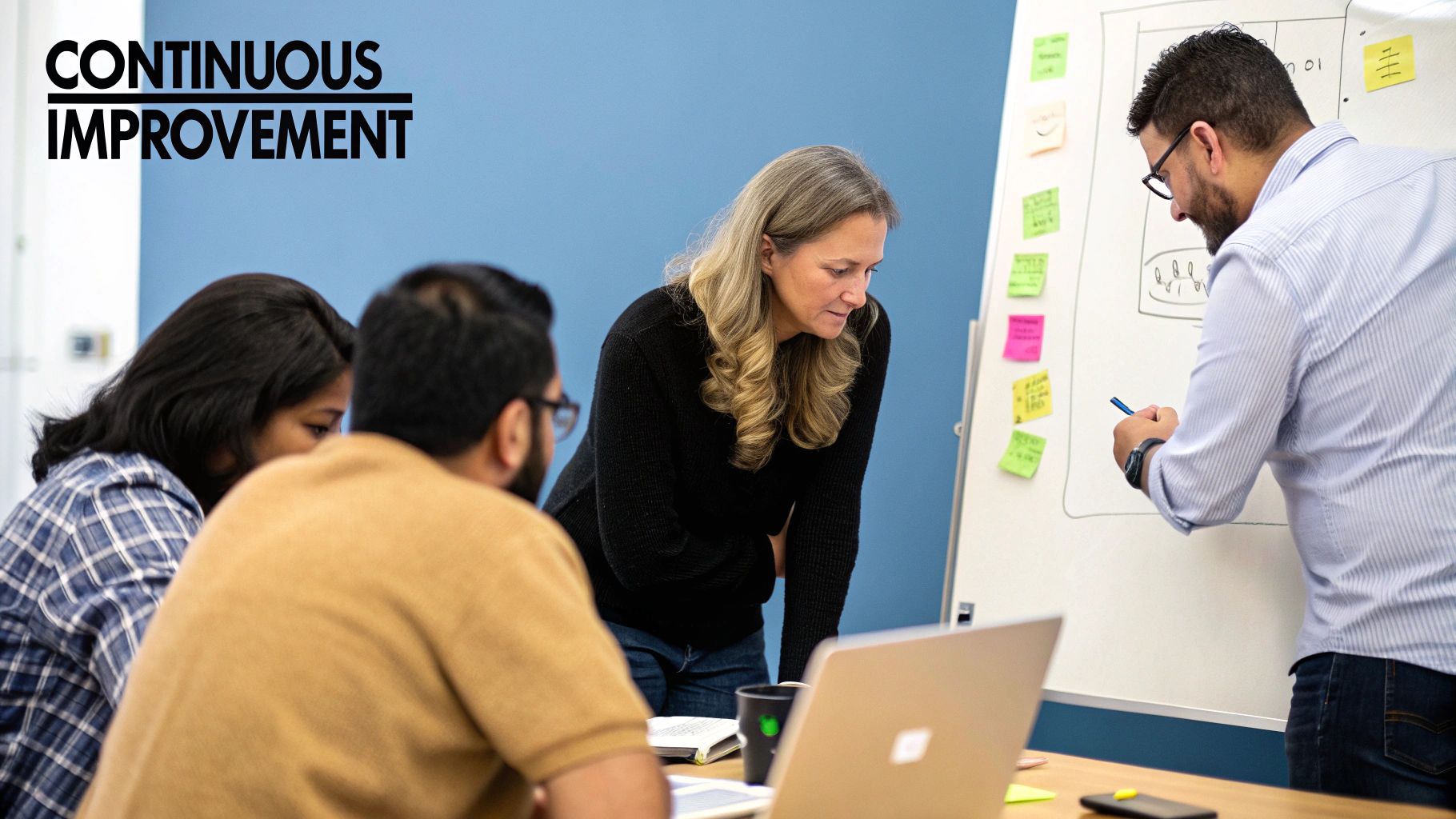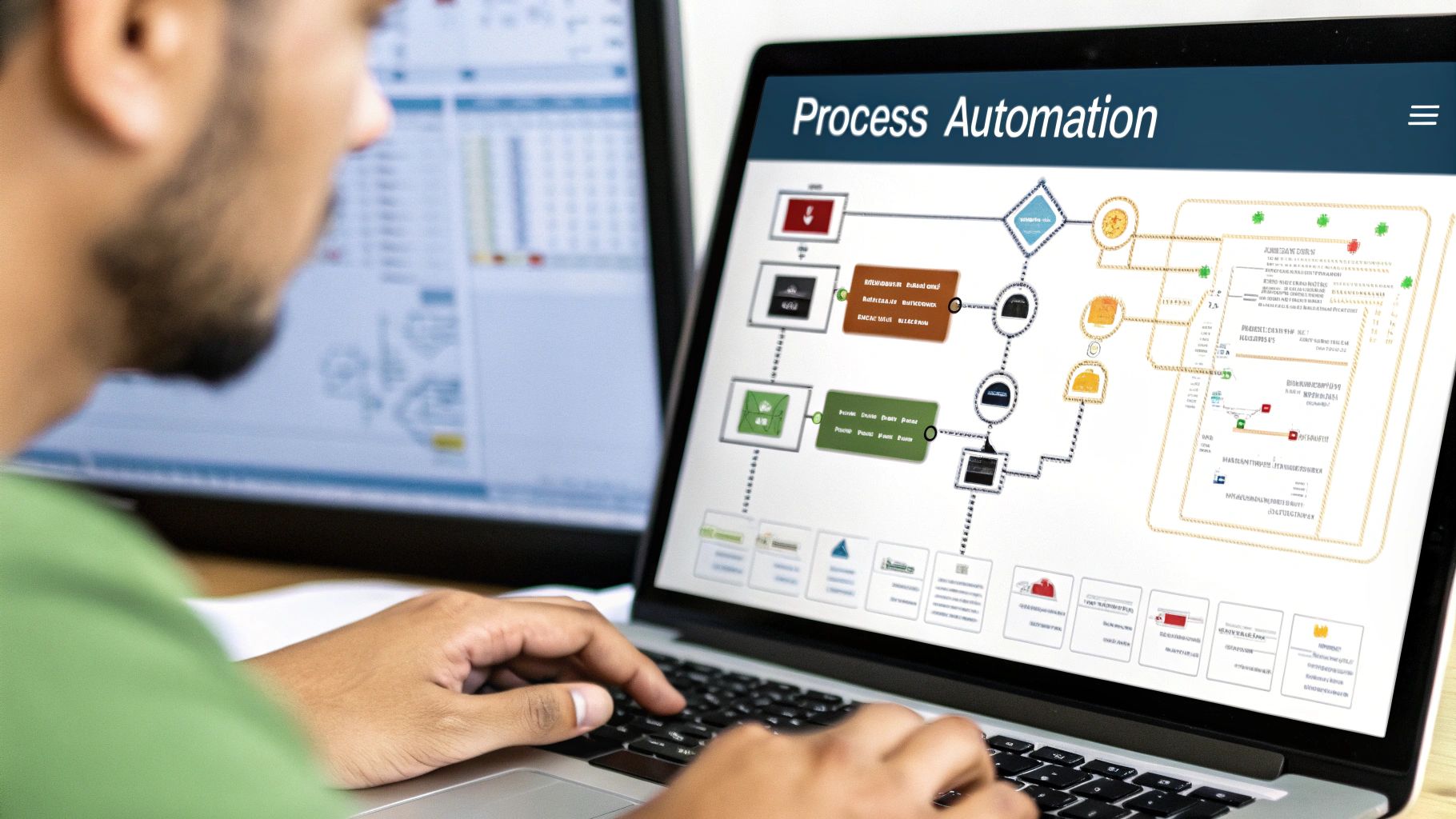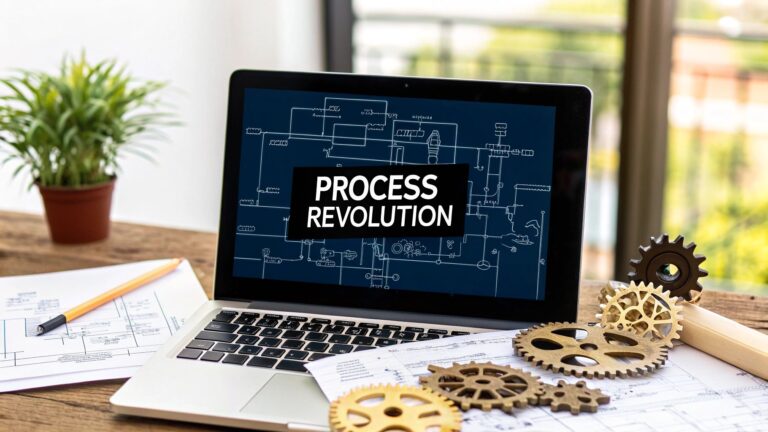10 Essential Business Process Improvement Methods for 2025
In a competitive market, efficiency isn't just a goal; it's a fundamental requirement for survival and growth. Every wasted minute, redundant task, and inefficient workflow directly impacts your bottom line, customer satisfaction, and team morale. For B2B and SaaS companies, where scalability and operational excellence are paramount, neglecting process optimization means leaving revenue on the table and giving competitors an edge. Streamlining your operations is no longer optional-it's the core engine for sustainable success.
This guide moves beyond theoretical concepts and dives straight into actionable frameworks. We will dissect ten powerful business process improvement methods that you can implement to drive tangible results. From eliminating waste with Lean Six Sigma to automating repetitive tasks with Robotic Process Automation (RPA), each methodology offers a unique toolkit for tackling specific operational challenges. To gain a broader understanding of the overarching concept of streamlining your operations, you can explore various resources on Business Process Improvement Methods.
You will learn how to identify bottlenecks, enhance quality, and foster a culture of continuous improvement. Whether you're a startup founder aiming to build a scalable foundation, a project manager at a digital agency, or a sales leader focused on automating lead generation, this article provides the practical steps needed to transform your processes. We will cover proven strategies like Kaizen, Value Stream Mapping, and Agile, equipping you with the knowledge to select and apply the right approach for your specific business needs. Forget abstract advice; this is your blueprint for building a more resilient, efficient, and profitable organization.
1. Lean Manufacturing/Lean Six Sigma
Lean Six Sigma is a powerful, data-driven methodology that combines two proven business process improvement methods: Lean and Six Sigma. Lean, famously perfected by Toyota, focuses relentlessly on eliminating "muda," or waste, from any process to maximize value for the customer. Six Sigma, developed by Motorola and popularized by General Electric, uses statistical analysis to systematically eliminate defects and reduce process variation.
Together, they create a comprehensive framework for achieving operational excellence. This approach is not just for manufacturing; B2B and SaaS companies use it to streamline software development cycles, optimize customer onboarding, and improve sales pipeline velocity. The core idea is to identify and remove non-value-adding activities, ensuring every step in a process contributes directly to a high-quality, customer-centric outcome.
When to Use This Method
Lean Six Sigma is most effective when you need to solve complex problems with unknown root causes. It excels in situations where you can measure inputs and outputs, such as reducing customer churn rates, decreasing software bug reports, or shortening the lead time for B2B service delivery. Its structured, project-based nature makes it ideal for tackling specific, high-impact challenges that require deep analysis rather than a quick fix.
The following infographic highlights the tangible business results you can expect when implementing Lean Six Sigma.
These metrics demonstrate that a successful Lean Six Sigma program delivers not only significant cost savings but also rapid, measurable returns and a more engaged workforce.
Actionable Implementation Tips
To effectively integrate this methodology, focus on tangible steps:
- Start with a Pilot: Select a well-defined process that is causing known pain points. A successful pilot project builds momentum and demonstrates value to stakeholders before a company-wide rollout.
- Invest in Training: Certify key team members as "Green Belts" or "Black Belts." This structured training ensures they have the statistical and project management skills to lead improvement initiatives effectively.
- Prioritize Customer Value: Apply Lean Six Sigma to processes that directly impact the customer experience. Improving these areas first often yields the highest return on investment. If you're ready to start, you can explore the 5 steps to implement Lean processes in your business.
2. Business Process Reengineering (BPR)
Business Process Reengineering (BPR) is a radical approach that involves fundamentally rethinking and completely redesigning core business processes to achieve dramatic improvements. Unlike incremental methods that tweak existing systems, BPR advocates for starting with a blank slate to reimagine how work gets done to dramatically boost performance metrics like cost, quality, service, and speed.
Pioneered by thinkers like Michael Hammer and James Champy, BPR challenges the assumptions and rules that underlie how a business operates. For B2B and SaaS companies, this could mean overhauling the entire customer support model from a tiered system to a specialized, single-point-of-contact system, or completely redesigning the sales-to-onboarding handoff. A classic example is Ford Motor Company, which reengineered its accounts payable process, reducing staff by 75% while improving accuracy by questioning the entire "match-the-invoice" paradigm.
When to Use This Method
BPR is not for minor adjustments; it is a high-risk, high-reward strategy best suited for situations where a company's processes are so broken or outdated that incremental improvements are insufficient. It is ideal when facing existential threats from new competitors, experiencing severe cost overruns, or when customer satisfaction has plummeted. If your SaaS company's time-to-market for new features is years behind the industry average, or your B2B service delivery is notoriously slow, a radical BPR initiative may be necessary for survival and growth.
Actionable Implementation Tips
Because BPR involves such profound change, a structured approach is critical for success:
- Secure Strong Executive Sponsorship: BPR initiatives cannot succeed without unwavering, visible support from the highest levels of leadership. Executive sponsors must champion the change, allocate resources, and clear organizational roadblocks.
- Invest Heavily in Change Management: This methodology fundamentally alters jobs and workflows, which can create fear and resistance. A robust change management and communication plan is essential to keep employees informed, engaged, and supportive of the new direction.
- Use Technology as an Enabler: Technology should facilitate the new process, not define it. First, design the optimal future-state process, then identify the technology (like CRM, ERP, or automation platforms) that will enable it most effectively.
- Plan for Significant Training: A redesigned process often requires new skills. You must develop comprehensive training programs to equip employees for their new roles and responsibilities. If you want to dive deeper, you can streamline your business processes with these proven techniques.
3. Kaizen (Continuous Improvement)
Kaizen is a Japanese philosophy that translates to "change for the better" or "continuous improvement." Popularized by figures like Masaaki Imai and perfected within Toyota's production system, this method is built on the belief that small, ongoing, positive changes can lead to major long-term improvements. It is a cultural mindset rather than a project-based tool, involving every employee from the C-suite to the front line in the process of identifying and eliminating inefficiencies.
The power of Kaizen lies in its incremental nature. Instead of pursuing disruptive, large-scale changes, teams focus on making small, low-cost, low-risk adjustments consistently. For a SaaS company, this could mean refining a single step in the user onboarding flow or improving the clarity of a support document. These minor tweaks accumulate over time, creating a culture of perpetual optimization and a significantly more efficient organization. For instance, Toyota famously implemented over a million employee-suggested improvements in a single year, demonstrating the massive cumulative impact of small ideas.

When to Use This Method
Kaizen is ideal for organizations looking to build a sustainable culture of improvement rather than just executing a one-off project. It works best when you want to empower your entire team to contribute to process enhancements and foster a sense of ownership. This approach is particularly effective for refining existing processes that are already functional but have room for optimization, such as improving customer support response times, streamlining internal communication workflows, or reducing waste in marketing campaign creation. Its focus on gradual change makes it less disruptive than other business process improvement methods.
Actionable Implementation Tips
To successfully cultivate a Kaizen culture, you need to empower and engage your team:
- Implement an Idea System: Create a simple, accessible system for employees to submit improvement suggestions. Ensure that every idea is reviewed promptly and that feedback is provided, even if the idea isn't implemented.
- Celebrate Small Wins: Publicly recognize and celebrate the small improvements made by teams and individuals. This reinforces the value of their contributions and maintains momentum for continuous change.
- Conduct Kaizen Events: Organize focused, short-term workshops (often called "Kaizen blitzes") where a cross-functional team collaborates to rapidly improve a specific process. This delivers quick results and teaches the methodology hands-on.
4. Total Quality Management (TQM)
Total Quality Management (TQM) is a comprehensive management philosophy that ingrains a commitment to quality into every facet of an organization. Popularized by pioneers like W. Edwards Deming, this approach empowers all employees, from the C-suite to the front line, to continuously improve processes, products, and services. The core principle is that achieving long-term success requires an unwavering focus on customer satisfaction and organizational excellence.
Unlike project-based methods, TQM is a cultural transformation. For B2B and SaaS companies, this means embedding quality into code development, customer support interactions, and sales processes. It’s not just about fixing bugs; it's about building a system that prevents them. Renowned examples like Motorola's drive for 99.9997% defect-free production and Xerox's journey to winning the Malcolm Baldrige National Quality Award highlight the transformative power of this business process improvement method.
When to Use This Method
TQM is ideal for organizations seeking to build a sustainable competitive advantage through superior quality and customer loyalty. It is particularly effective when you want to shift from a reactive "firefighting" mode to a proactive culture of prevention. If your SaaS company is struggling with inconsistent service delivery, or your B2B firm faces high customer churn due to recurring issues, TQM provides a holistic framework to address these systemic problems by involving everyone in the solution.
Actionable Implementation Tips
To successfully adopt TQM, focus on embedding it into your company’s DNA:
- Secure Leadership Commitment: TQM must be driven from the top. Leaders need to articulate a clear vision for quality and consistently model the desired behaviors and commitment.
- Implement Comprehensive Training: Equip all employees with the knowledge and tools they need to contribute. This includes training on quality principles, problem-solving techniques, and statistical process control.
- Establish Quality Circles: Create cross-functional teams dedicated to identifying and solving quality-related problems within their areas. This fosters collaboration and empowers employees to take ownership of process improvements.
- Define and Track Metrics: Establish clear, measurable quality metrics that align with customer satisfaction. Regularly review these metrics in team meetings to track progress and identify new areas for improvement.
5. Value Stream Mapping (VSM)
Value Stream Mapping (VSM) is a lean management technique used to visualize, analyze, and improve all the steps in a product delivery process. Popularized by Toyota Production System practitioners like Mike Rother and John Shook, it goes beyond a simple flowchart. VSM illustrates both the flow of materials and the flow of information required to guide a product or service from its beginning to the end customer. By mapping the entire journey, teams can clearly distinguish between value-adding and non-value-adding activities, or "waste."
This visualization makes it one of the most effective business process improvement methods for identifying bottlenecks, redundancies, and delays. For SaaS companies, a value stream could map the entire process from a new feature idea to its deployment and use by customers. B2B service firms might map the journey from initial client contact to final project delivery. The goal is to create a "future state" map that streamlines the process, shortens lead times, and enhances overall value.
When to Use This Method
VSM is ideal when you need a holistic, high-level view of an entire process rather than focusing on a single, isolated step. Use it when you want to understand the complete end-to-end customer journey and identify systemic inefficiencies. It is particularly powerful before embarking on major improvement projects, as it helps prioritize where to focus your efforts for maximum impact, such as reducing the overall cycle time for product development or improving B2B client onboarding efficiency.
The following video provides a clear overview of how to create and use a Value Stream Map.
This visual approach aligns cross-functional teams, from sales to development to support, around a shared understanding of the current state and a unified vision for the future.
Actionable Implementation Tips
To apply VSM effectively, consider these practical steps:
- Walk the Process: Before drawing a single box, physically or virtually walk the entire process as it currently exists. This "gemba walk" reveals the gap between the documented process and what actually happens day-to-day.
- Map Information and Material Flows: A key differentiator of VSM is its inclusion of information flow. Map how teams communicate, how work is scheduled, and how information is passed between steps, as this is often where hidden delays occur.
- Focus on a Single Value Stream: Don't try to map your entire organization at once. Select one specific product family or service line, such as "new enterprise customer onboarding," to create a detailed and manageable map. This focused approach yields more actionable insights.
6. PDCA Cycle (Plan-Do-Check-Act)
The PDCA Cycle, also known as the Deming Wheel, is an iterative, four-stage management method used for the continuous improvement of processes and products. Popularized by W. Edwards Deming and fundamental to the Toyota Production System, it provides a simple yet powerful framework for solving problems and implementing change. The cycle's strength lies in its cyclical nature, ensuring that improvement is not a one-time event but an ongoing, ingrained business practice.
This methodology encourages a scientific, hypothesis-driven approach to enhancements. B2B and SaaS companies leverage PDCA for agile software development sprints, refining user onboarding flows, or optimizing marketing campaigns. The goal is to create a feedback loop where teams systematically plan a change, implement it on a small scale, check the results against expectations, and act to standardize the improvement or begin the cycle again. This makes it one of the most foundational business process improvement methods for fostering a culture of continuous learning.
When to Use This Method
The PDCA Cycle is ideal for implementing continuous, incremental improvements rather than radical, one-off overhauls. Use it when you want to test a hypothesis for improvement in a controlled way before committing to a full-scale rollout. It works exceptionally well for refining existing processes, such as reducing ticket resolution times in customer support, improving sales conversion rates for a specific funnel stage, or enhancing the efficiency of content production workflows. Its simplicity makes it highly accessible for teams at all levels without requiring extensive statistical training.
Actionable Implementation Tips
To effectively integrate the PDCA cycle, focus on discipline and repetition:
- Keep Cycles Short: Fast, iterative cycles maintain momentum and accelerate learning. Aim for short sprints that allow you to test changes quickly, gather data, and adapt without losing focus or team engagement.
- Pilot in the 'Do' Phase: When implementing a change (the "Do" stage), always start with a small-scale pilot. This minimizes risk and allows you to validate your plan with real-world data before a wider, more resource-intensive deployment.
- Involve the Whole Team: Ensure team members participate in all four phases. Collective involvement in planning, doing, checking, and acting fosters greater buy-in, ownership, and more comprehensive insights. You can learn more about its application in the ASQ's detailed guide to the PDCA cycle.
7. Process Mining
Process Mining is a data-driven discipline that uses event log data from IT systems (like your CRM, ERP, or project management software) to discover, monitor, and improve real-world business processes. It acts like an X-ray for your operations, creating a dynamic, visual map of how work actually gets done, rather than how you think it gets done in theory. This provides objective, fact-based insights into hidden bottlenecks, process deviations, and areas of inefficiency.
Pioneered by computer scientist Wil van der Aalst and commercialized by firms like Celonis, Process Mining bridges the gap between traditional process analysis and modern data science. For B2B and SaaS companies, it can reveal inefficiencies in the customer journey, from lead-to-cash cycles to support ticket resolution, by analyzing the digital footprints left behind in company systems. Siemens, for example, used this method to visualize its order-to-cash process, uncovering bottlenecks that led to a 20% reduction in processing time.
When to Use This Method
Process Mining is exceptionally powerful when you have a complex process with a strong digital footprint but lack visibility into its actual performance. It is the ideal method when you suspect inefficiencies but cannot pinpoint the exact cause or location. Use it to diagnose issues in high-volume, multi-step processes like procurement, customer onboarding, or claims processing. If your process relies heavily on IT systems and you need to base your improvements on hard data rather than assumptions, Process Mining is your best choice among the various business process improvement methods.
Actionable Implementation Tips
To effectively leverage Process Mining, focus on a structured approach:
- Start with a Good Digital Footprint: Choose a process that is well-documented within your information systems. Processes like sales pipeline management in a CRM or software deployment cycles tracked in Jira are excellent candidates because they generate rich event logs.
- Ensure Data Quality: Before analysis, work with your IT team to ensure the data is clean, complete, and accurate. Each event log needs a case ID, an activity name, and a timestamp to be useful. Garbage in, garbage out is especially true here.
- Combine with Domain Expertise: Technology alone is not enough. Pair the data insights from Process Mining tools with the knowledge of team members who execute the process daily. They can provide the context behind the data, explaining why deviations or delays occur. You can learn more about how to get started on the Process Mining: Data science in Action course.
8. Robotic Process Automation (RPA)
Robotic Process Automation (RPA) is a technology that leverages software "bots" to automate highly repetitive, rule-based digital tasks that humans typically perform. Unlike traditional automation that often requires complex integrations, RPA bots interact with existing applications and systems through the user interface, just like a person would. This allows for rapid deployment without altering the underlying IT infrastructure.
In a B2B or SaaS context, RPA is used to automate tasks like data entry, invoice processing, and report generation. For example, a bot can be programmed to log into a CRM, extract sales data, compile it into a weekly report, and email it to stakeholders. This frees up skilled employees from mundane work, allowing them to focus on strategic, value-added activities. Exploring real-world business process automation examples can provide valuable insights into its practical applications and impact.

When to Use This Method
RPA is ideal for processes that are high-volume, highly standardized, and prone to human error. Use it when you need to increase speed and accuracy in back-office functions like finance, HR, and customer service. Tasks such as processing customer service requests, managing invoices, or onboarding new employees are prime candidates. Companies like Telefónica have successfully used it to reduce invoice processing time by 60%, showcasing its power to deliver measurable efficiency gains.
Actionable Implementation Tips
To successfully deploy RPA as one of your business process improvement methods, consider these practical steps:
- Start Small: Begin by automating a high-volume, low-complexity process. This "quick win" approach helps demonstrate ROI and builds support for broader implementation.
- Ensure Process Stability: Before automating, make sure the target process is stable, well-documented, and optimized. Automating a flawed or inefficient process will only amplify its problems.
- Establish Governance: Develop a clear governance framework for managing your bots. This includes defining roles, monitoring performance, and creating protocols for handling exceptions or system changes.
- Prioritize Change Management: Proactively address employee concerns about automation by communicating its benefits. Frame RPA as a tool that augments human capabilities, not replaces them, which is a key concept in modern AI workflow automation tools.
9. Agile Methodology
Agile is an iterative approach to project management and process improvement that prioritizes flexibility, customer collaboration, and rapid delivery. Born from the world of software development and formalized in the 2001 Agile Manifesto, its principles are now widely adopted across diverse business functions. The core idea is to break down large projects into small, manageable increments called "sprints," allowing teams to adapt to changing requirements and deliver value continuously.
This methodology moves away from rigid, long-term planning and embraces dynamic adjustments based on real-time feedback. In the B2B and SaaS space, this means teams can quickly pivot product features based on early user data or refine marketing campaigns mid-flight to improve performance. For example, Spotify famously scaled its entire organization using Agile principles with its "squad" model, empowering small, autonomous teams to innovate and improve processes independently.
When to Use This Method
Agile is ideal for projects where the final outcome is not fully defined at the start or where market conditions are expected to change. It thrives in dynamic environments requiring rapid innovation, such as developing new software features, launching a marketing campaign, or optimizing a sales process. If your team needs to respond quickly to customer feedback and deliver functional results in short cycles rather than waiting for one "big bang" launch, Agile is one of the most effective business process improvement methods available.
Actionable Implementation Tips
To effectively adopt an Agile approach, consider these practical steps:
- Start with Pilot Teams: Select one or two teams to test Agile practices on a specific project. Their success will create a compelling case study and provide valuable lessons for a wider rollout, demonstrating its value without disrupting the entire organization.
- Invest in Training: Ensure teams are trained not just on specific frameworks like Scrum or Kanban but on the underlying Agile principles of collaboration, empowerment, and customer focus. This foundational knowledge is key to a successful cultural shift.
- Create Cross-Functional Teams: Assemble teams with all the necessary skills (e.g., marketing, sales, engineering) to complete a project from start to finish. Granting these teams decision-making authority eliminates bottlenecks and accelerates progress. You can explore how companies like ING Bank restructured their entire organization using Agile on their official journey page.
10. Design Thinking
Design Thinking is a human-centered, iterative approach to problem-solving that focuses on understanding the end user's needs to create better products, services, and internal processes. Popularized by firms like IDEO and Stanford's d.school, it integrates empathy for the user, the possibilities of technology, and the requirements for business success. This methodology moves beyond traditional process analysis by putting the user experience at the core of the solution.
Instead of starting with a business problem, Design Thinking begins by deeply understanding the people the process serves. For B2B and SaaS companies, this means redesigning complex software interfaces, streamlining customer support workflows, or improving the sales cycle based on genuine customer pain points. GE Healthcare famously used it to transform the intimidating MRI experience for children into an adventure, dramatically improving patient cooperation and process efficiency.
When to Use This Method
Design Thinking is the ideal method when you are tackling ambiguous or ill-defined problems where the human element is paramount. It shines when you need to innovate rather than just optimize. Use it to reimagine customer onboarding, develop new software features that users will actually adopt, or improve employee engagement with internal systems. Its strength lies in uncovering unmet needs and generating breakthrough solutions that data analysis alone might miss.
This method is less about incremental improvements and more about transformational change driven by user empathy. If your current processes are technically efficient but still result in low user satisfaction or adoption, Design Thinking is one of the best business process improvement methods to employ.
Actionable Implementation Tips
To apply Design Thinking effectively, prioritize empathy and rapid experimentation:
- Immerse in the Empathy Phase: Don't rush this initial stage. Conduct in-depth interviews, observation sessions, and surveys to genuinely understand the user's experience, frustrations, and motivations. The insights gathered here are the foundation for a successful outcome.
- Build Diverse, Cross-Functional Teams: Assemble teams with members from different departments like engineering, marketing, sales, and support. A variety of perspectives is crucial for generating creative and holistic solutions.
- Prototype and Test Relentlessly: Create low-fidelity prototypes like sketches, wireframes, or role-playing scenarios. Test these early and often with real users to gather feedback, learn quickly, and iterate before investing significant resources in development. A great starting point is learning about the five stages of the Design Thinking process.
Business Process Improvement Methods Comparison
| Methodology | Implementation Complexity | Resource Requirements | Expected Outcomes | Ideal Use Cases | Key Advantages |
|---|---|---|---|---|---|
| Lean Manufacturing/Lean Six Sigma | Moderate to high (cultural change & training needed) | Skilled personnel, statistical tools, ongoing training | Cost reduction (15-25%), quality improvement, ROI in 6-12 months | Manufacturing, service operations seeking waste reduction | Combines waste elimination with defect reduction; measurable ROI |
| Business Process Reengineering (BPR) | High (radical redesign, massive change) | Significant organizational resources, IT investment | Breakthrough performance improvements (50-100%) | Large enterprises needing dramatic process overhaul | Enables dramatic improvements and competitive advantage |
| Kaizen (Continuous Improvement) | Low to moderate (incremental changes, employee-driven) | Low cost, employee involvement | Sustainable long-term improvements, enhanced engagement | Organizations focusing on continuous, gradual improvement | Low risk, builds continuous improvement culture |
| Total Quality Management (TQM) | High (long-term cultural transformation) | Organization-wide commitment, extensive training | Improved customer satisfaction, defect reduction, morale boost | Organizations aiming for comprehensive quality focus | Holistic approach fostering excellence and sustainability |
| Value Stream Mapping (VSM) | Low to moderate (mapping and analysis) | Training for mapping, cross-functional teams | Visualization of process flow, bottleneck identification | Lean initiatives, process flow analysis | Clear visualization facilitating waste identification |
| PDCA Cycle (Plan-Do-Check-Act) | Low (simple iterative cycle) | Minimal; requires discipline | Gradual, data-driven process improvements | Any organization seeking structured continuous improvement | Easy to understand and apply; promotes learning from results |
| Process Mining | Moderate to high (data and IT intensive) | High-quality event logs, IT infrastructure | Objective process insight, bottleneck detection | Data-rich environments aiming to improve process compliance | Automated discovery and real-time monitoring |
| Robotic Process Automation (RPA) | Moderate to high (technology set-up) | IT infrastructure, bot development, governance | Cost reduction (25-50%), increased accuracy, speed | Repetitive, rule-based tasks across industries | Rapid ROI, frees employees for higher-value tasks |
| Agile Methodology | Moderate (cultural shift, team collaboration) | Training, cross-functional teams | Faster adaptation, improved collaboration | Software development, adaptable business projects | Flexible, feedback-driven iterative improvements |
| Design Thinking | Moderate (iterative, user-focused) | Cross-disciplinary teams, prototyping resources | Innovative, user-centered solutions | Complex problems requiring innovative solutions | Human-centered, empathy-based innovation method |
From Theory to Action: Choosing and Implementing Your Method
We've journeyed through a comprehensive landscape of ten powerful business process improvement methods, from the waste-eliminating principles of Lean Six Sigma to the user-centric innovation of Design Thinking. The sheer variety can seem overwhelming, but this diversity is your greatest asset. It signifies that no matter your industry, company size, or specific operational challenge, there is a structured framework designed to help you achieve greater efficiency, quality, and value.
The core takeaway is this: Business process improvement is not a one-time project with a definitive endpoint. It's a cultural mindset, a commitment to perpetual refinement. Whether you adopt the incremental, employee-driven philosophy of Kaizen or the radical, top-down overhaul of Business Process Reengineering (BPR), the goal remains the same: to build a more resilient, agile, and competitive organization. Your task now is to translate this theoretical knowledge into tangible action.
Synthesizing Your Approach: From Selection to Execution
Choosing the right method isn't about finding the single "best" one; it's about finding the right fit for your immediate problem and long-term vision. A SaaS startup struggling with inconsistent customer onboarding might find immediate value in Value Stream Mapping (VSM) to identify bottlenecks, followed by implementing Agile principles to iterate on a better solution. In contrast, a mature digital agency aiming to enhance service delivery quality might gravitate towards Total Quality Management (TQM) to embed a customer-first focus across every department.
Here is a practical roadmap to get you started:
-
Start Small, Win Big: Don't attempt a company-wide BPR initiative as your first step. Select one high-impact, low-complexity process that is causing noticeable pain. Use a simpler framework like the PDCA Cycle to run a pilot project. A quick win will build momentum and secure buy-in for more ambitious improvements.
-
Map Before You Act: Before you can improve a process, you must understand it. Tools like Value Stream Mapping and Process Mining are not just for experts; they are essential diagnostic tools. Visually charting the flow of work, data, and approvals will instantly illuminate redundancies and delays you never knew existed.
-
Embrace Technology as an Enabler: Modern methods like Robotic Process Automation (RPA) and Process Mining are force multipliers. While principles like Lean and Kaizen provide the "why" and "what," technology provides the "how." For instance, after using VSM to identify manual data entry as a major bottleneck in your sales-to-finance handoff, you can use RPA to automate it entirely. To help bridge the gap from theory to practical application, you can explore these practical business process automation examples to see how automation is transforming workflows.
Key Insight: The most effective strategies often blend methodologies. You might use Design Thinking to understand customer pain points, VSM to map the current process, Agile to develop a solution, and RPA to automate the final, optimized workflow.
The Lasting Impact of Continuous Improvement
Mastering these business process improvement methods is more than an operational exercise; it's a strategic imperative. It empowers your teams to solve their own problems, fosters a culture of accountability and innovation, and directly impacts your bottom line by reducing costs and increasing output. As you move forward, focus not just on the tools but on the principles behind them: eliminating waste, valuing customer feedback, and empowering employees. By embedding this thinking into your company's DNA, you build an organization that doesn't just survive change but thrives on it, consistently delivering superior value to your customers and stakeholders.
Ready to automate the processes you've just improved? MakeAutomation provides a powerful, no-code platform that allows you to connect your favorite apps and build sophisticated workflows in minutes. Stop wasting time on manual tasks and start focusing on growth with MakeAutomation.







